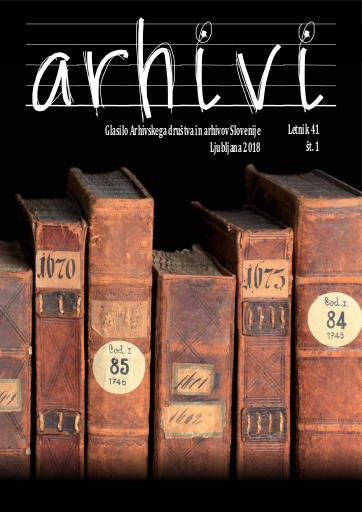/
Serijske publikacije
/
Arhivi
Skrb za javno zdravstvo v fondih uprave na območju Zgodovinskega arhiva Celje od druge polovice 19. stoletja do 1941

Avtor(ji):Hedvika Zdovc
Soavtor(ji):Gregor Jenuš (gl. in odg. ur.), Marija Grabnar (ur.), Dunja Mušič (teh. ur.), Petra Markuš (prev.), Marija Grabnar, Andreja Klasinc Škofljanec in Borut Jurca (foto.)
Leto:2018
Založnik(i):Arhivsko društvo Slovenije, Ljubljana
Vir(i):Arhivi, 2018, št. 1
Jezik(i):slovenščina
Vrst(e) gradiva:besedilo
Ključne besede:ČLANKI IN RAZPRAVE, zdravnik, babica, nalezljiva bolezen, izolirna hiša, cepljenje, ambulanta, zdravstveno okrožje, bolnišnica, ARTICLES AND PAPERS, physician, midwife, infectious disease, isolated house, inoculation, ambulatory care clinic, health care county, hospital
Avtorske pravice:

To delo avtorja Hedvika Zdovc je ponujeno pod Creative Commons Priznanje avtorstva-Nekomercialno-Deljenje pod enakimi pogoji 4.0 Mednarodna
Datoteke (1)

Ime:ARHIVI_2018-1.pdf
Velikost:12.28MB
Format:application/pdf
Stalna povezava:https://hdl.handle.net/11686/file25398
Opis
Public health care service was organized anew by the Austrian Medical
Act in 1870. On the basis of this act, countries issued regional acts for arrangement of health service in municipalities. Concern for human health was one of
the tasks of municipalities. Health care service in municipalities was performed
by doctors (county, district, and municipal) and ancillary health care (district
nurses, midwives, hospital attendants).
Until the end of 1912, Dr Josef Marcius, who received wages of 1960 K,
was the district doctor (for entire Trbovlje municipality, Dol municipality, and
cadastral municipalities Marna, Sv. Štefan, and Sv. Jedert), on 1 January 1913
replaced by municipal doctor Dr Anton Jamar. Midwives provided assistance
in childbirth. Midwives had to keep a journal or record of childbirths (childbirth report) and provide the official doctor with access to it. In 1920, 14 midwives performed the delivery in political district Brežice. Municipalities were
particularly sensitive to infectious diseases. On the outbreak of infectious diseases (scarlatina, diphtheria, typhoid, torticollis, measles, smallpox, dysentery
etc.) and against the spreading of the diseases, midwives were obligated to follow general instructions issued by the District Board Celje for the territory of
its medical district (parboiling objects in lye, disinfection with the solution of
Lysol, carbolic solution, lime milk or quicklime, boiling water, room disinfection
...). Isolated houses were also important to prevent the spread of an infectious
disease among citizens as isolation of a patient proved to be a successful preventive measure. This is the reason for the decision of municipality of Trbovlje
to build a new isolated house in 1895 on the plot no. 294 of cadastral municipality Trbovlje. The building was completed in January 1896 and could take up to
30 patients. Preventive inoculations of children and adults were effective protection against infectious diseases were. Municipality had to prepare a special
room and set a date of implementation of vaccination, which was then carried
out by a competent doctor who was required to keep a journal of vaccination.
To maintain cleanliness of workers’ housing, municipalities performed sanitary
inspections, strived to acquire new outpatient premises and hospitals, and took
care of the payment for patient care in public hospitals if patients or their family
could not afford to pay the bills. Preserved archival material in the fonds of administrative authorities functioning from the 19th century to 1941 in the area
of Historical Archives Celje presents an important source for studying health
care activities during that period. Because the documents were established in
administrative operation among administrative authorities and health care providers on the field, textual records are predominant (minutes, reports, statistical records, statements, journals of performed tasks etc.), and also building
plans or photos as annexes to textual records.
Metapodatki (12)
- identifikatorhttps://hdl.handle.net/11686/41587
- naslov
- Skrb za javno zdravstvo v fondih uprave na območju Zgodovinskega arhiva Celje od druge polovice 19. stoletja do 1941
- Care for Public Health System in the Fonds of Administration in the Area of Historical Archives Celje from the Second Half of the 19th Century to 1941
- avtor
- Hedvika Zdovc
- soavtor
- Gregor Jenuš (gl. in odg. ur.)
- Marija Grabnar (ur.)
- Dunja Mušič (teh. ur.)
- Petra Markuš (prev.)
- Marija Grabnar, Andreja Klasinc Škofljanec in Borut Jurca (foto.)
- predmet
- ČLANKI IN RAZPRAVE
- zdravnik
- babica
- nalezljiva bolezen
- izolirna hiša
- cepljenje
- ambulanta
- zdravstveno okrožje
- bolnišnica
- ARTICLES AND PAPERS
- physician
- midwife
- infectious disease
- isolated house
- inoculation
- ambulatory care clinic
- health care county
- hospital
- opis
- Public health care service was organized anew by the Austrian Medical Act in 1870. On the basis of this act, countries issued regional acts for arrangement of health service in municipalities. Concern for human health was one of the tasks of municipalities. Health care service in municipalities was performed by doctors (county, district, and municipal) and ancillary health care (district nurses, midwives, hospital attendants). Until the end of 1912, Dr Josef Marcius, who received wages of 1960 K, was the district doctor (for entire Trbovlje municipality, Dol municipality, and cadastral municipalities Marna, Sv. Štefan, and Sv. Jedert), on 1 January 1913 replaced by municipal doctor Dr Anton Jamar. Midwives provided assistance in childbirth. Midwives had to keep a journal or record of childbirths (childbirth report) and provide the official doctor with access to it. In 1920, 14 midwives performed the delivery in political district Brežice. Municipalities were particularly sensitive to infectious diseases. On the outbreak of infectious diseases (scarlatina, diphtheria, typhoid, torticollis, measles, smallpox, dysentery etc.) and against the spreading of the diseases, midwives were obligated to follow general instructions issued by the District Board Celje for the territory of its medical district (parboiling objects in lye, disinfection with the solution of Lysol, carbolic solution, lime milk or quicklime, boiling water, room disinfection ...). Isolated houses were also important to prevent the spread of an infectious disease among citizens as isolation of a patient proved to be a successful preventive measure. This is the reason for the decision of municipality of Trbovlje to build a new isolated house in 1895 on the plot no. 294 of cadastral municipality Trbovlje. The building was completed in January 1896 and could take up to 30 patients. Preventive inoculations of children and adults were effective protection against infectious diseases were. Municipality had to prepare a special room and set a date of implementation of vaccination, which was then carried out by a competent doctor who was required to keep a journal of vaccination. To maintain cleanliness of workers’ housing, municipalities performed sanitary inspections, strived to acquire new outpatient premises and hospitals, and took care of the payment for patient care in public hospitals if patients or their family could not afford to pay the bills. Preserved archival material in the fonds of administrative authorities functioning from the 19th century to 1941 in the area of Historical Archives Celje presents an important source for studying health care activities during that period. Because the documents were established in administrative operation among administrative authorities and health care providers on the field, textual records are predominant (minutes, reports, statistical records, statements, journals of performed tasks etc.), and also building plans or photos as annexes to textual records.
- založnik
- Arhivsko društvo Slovenije
- datum
- 2018
- 01. 01. 2018
- tip
- besedilo
- jezik
- Slovenščina
- jeDelOd
- pravice
- licenca: ccByNcSa
